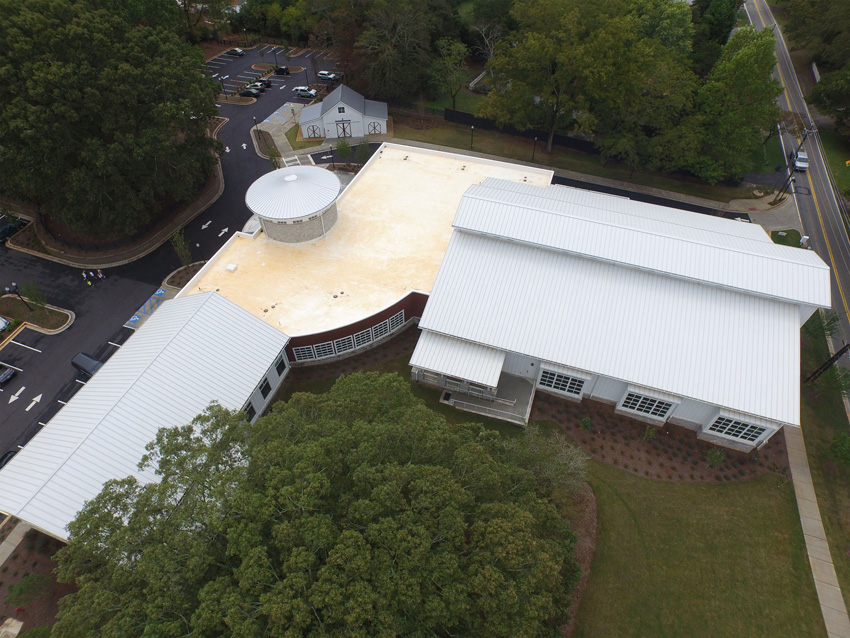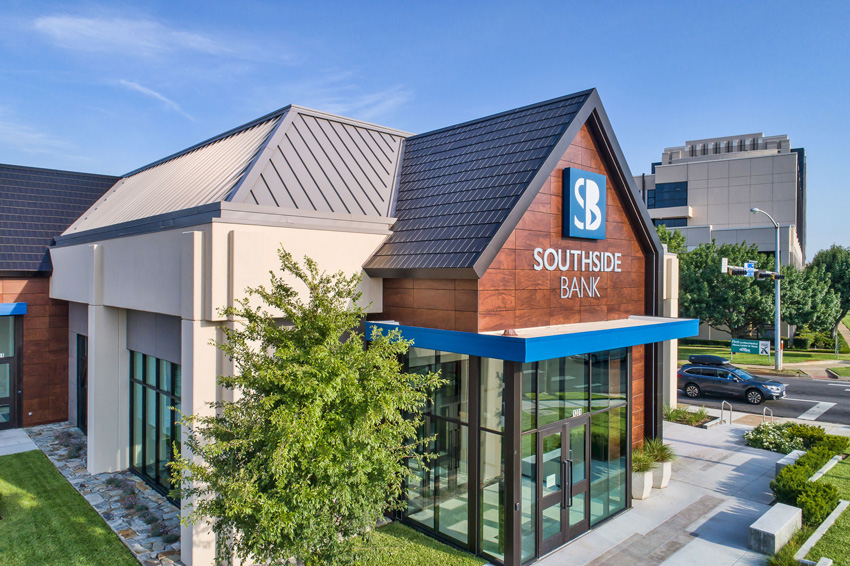Achieving Design Objectives with Metal Roofs and Facades
Recycled and Recyclable
“Metal is also a more environmentally friendly material to select for a roof,” Kipnis adds. “Although asphalt shingles are more commonly used, asphalt is a byproduct of crude-oil refining. The metal we used for the standing-seam roof contains recycled content and can be recycled at the end of its useful life, which addresses many of the materials-focused concerns that are an important part of green buildings.”
Steel and aluminum are 100 percent recyclable and can be milled with pre-consumer and post-consumer recycled content. In fact, the two contemporary processes used to produce new steel require old steel, and so steel inherently contains recycled content and is recognized as having a previously established industry average of 25 percent post-consumer recycled content. This means that incorporating steel products into a project can help to achieve recycled content thresholds without requiring the product-specific documentation often required.
In addition, green-building rating systems like LEED v4 now encourage the use of products and materials for which life-cycle information is available and that have favorable life-cycle impacts. Points are awarded for specifying materials into a project that disclose life-cycle assessments (LCAs) or make product-specific environmental product declarations (EPDs) available.
Leed-Silver-Certified Milton Library
The 25,000-square-foot state-of-the-art Milton Library earned a LEED Silver certification in 2016 and the prestigious 2016 Metro Atlanta Chamber of Commerce M3 Award for the Built Environment category. Designed by Stevens & Wilkinson of Atlanta in association with 720 Design of Dallas, the building reflects the equestrian and agrarian history of Georgia’s Fulton County with a distinctive farmhouse look that features a silo element that serves as the main entrance. The various forms in the design are capped with a roof that combines two gabled roof elements and a small membrane roof with a high and circular roof line above the silo, marking the entryway.

Photo: Courtesy of PAC-CLAD | Petersen
The cool standing-seam metal roof at the Milton Library, finished in stone white, helps to keep the interior comfortable, supports rainwater harvesting for improved water efficiency, and contains recycled content.
Creating a high-performance and energy-efficient building requires that the structure be equipped to manage solar radiation. The design of the Milton Library minimized solar heat gain with thoughtful orientation and a cool metal roof. The roof is constructed from two types of metal panels. The roof of the silo is clad with metal tapered panels, while standard metal panels are used on rest of the building.
Both are finished with a cool white coating that enhances the metal surface’s ability to reflect and re-emit the solar radiation that impact it. The reflectivity of the metal panels used on the Milton Library roof is 0.67, and the thermal emissivity value is 0.85, delivering a cool roof with an SRI value of 80. This ultimately keeps the building cooler and reduces the amount of energy that must be used to maintain a comfortable interior, even during the hot summer months in Georgia.
Water efficiency was also an important sustainability goal of the project, so low-flow plumbing fixtures were selected and xeriscaping was incorporated into the design. Xeriscape is a type of landscaping that features native, drought-resistant plants arranged in ways that are particularly water efficient. A properly xeriscaped lawn can reduce outdoor water use by 60 percent or more. The project also implemented a stormwater-management plan that reduced impervious hardscapes, promoting the infiltration of groundwater at the site and capturing stormwater runoff for reuse. The cool metal roof contributes toward water efficiency of the project by effectively shedding rainwater to be captured by the rainwater-harvesting system.
A lot of consideration was also given to the type of energy used on-site and materials selected for the project. The parking lot encourages carpooling and gives priority spaces to visitors who travel in low-emitting, fuel-efficient vehicles. The project also purchased a two-year renewable energy contract to offset more than 70 percent of the building’s energy use. Specifying materials with recycled content, such as a metal roof, also reduced the environmental impact of the project by decreasing the need for the extraction of virgin materials.
Metal Roofs Contribute toward LEED Points
Beyond supporting a wide variety of sustainability criteria, a metal roof can contribute toward earning specific credits in the LEED v4 green-building rating system. In the Sustainable Sites category, a metal roof can help a project satisfy the Heat Island Reduction credit and the Rainwater Management credit. In the Water Efficiency category, a metal roof can contribute toward achieving credits for reducing water use both indoors and outdoors. A metal roof can also help a project earn Optimize Energy Performance and Renewable Energy Production credits in the Energy & Atmosphere category. There are multiple credits in the Materials & Resources category that can be supported by the selection of a metal roof, including Building Life-Cycle Impact Reduction, Building Product Disclosure and Optimization, and Construction and Demolition Waste Management. The metal roof can also contribute toward earning the Thermal Comfort credit in the Indoor Environmental Quality category.
Distinct and Dramatic Exteriors
Whether using metal panels in the roof or facade of a project, the material enables designers to achieve distinct and dramatic exteriors that make an impression. From creating a continuous element that can run from the top to the bottom of a building, functioning as both roof and wall, to designing an unbroken horizontal line around the building, metal panels can be used to break the traditional box style. Curved roofs and perforated panels enable designers to redefine the form of a building, creating awe and engaging audiences with unique views into the structure. A broad palette of colors can be used to create bold mosaics that generate visual interest and appeal. Here are a few examples of how designers have used metal panels to create noteworthy and high-performance exteriors.

Photo: Tom Coplen
During the renovation of Southside Bank’s flagship branch, metal tiles and a metal standing-seam roof were selected to update and enhance the gable roof.









